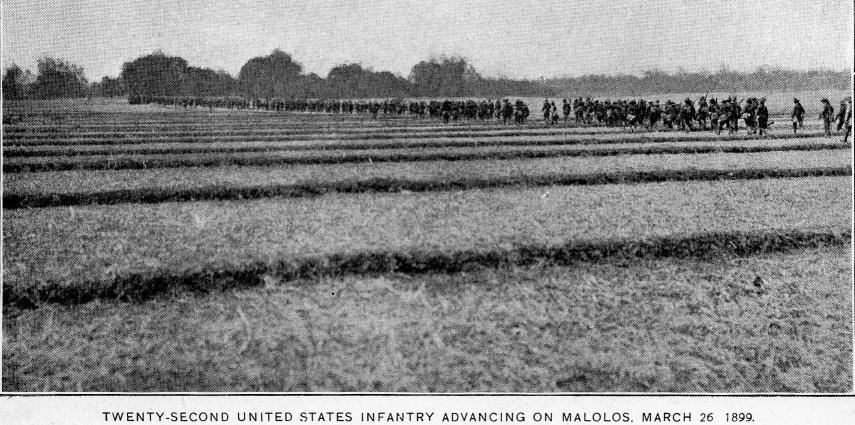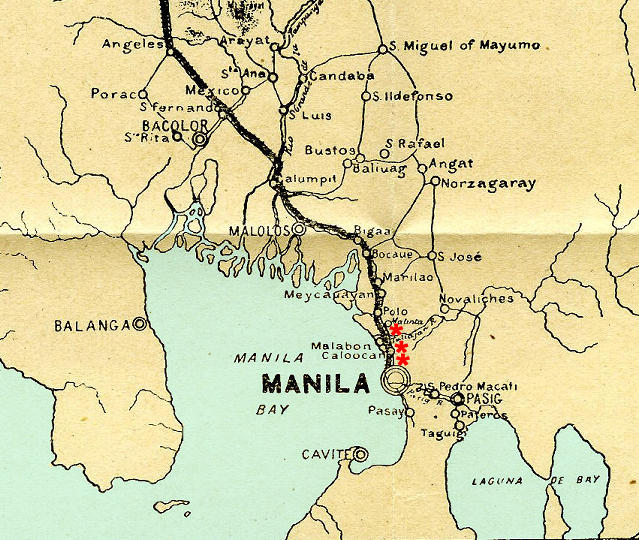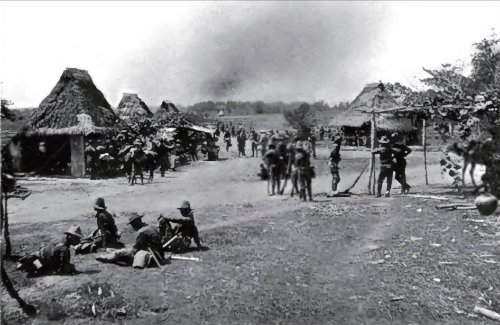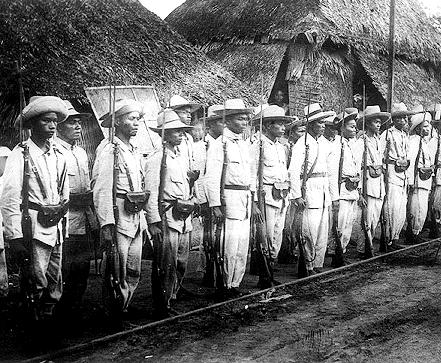![]() 1st Battalion 22nd Infantry
1st Battalion 22nd Infantry ![]()
The 22nd Infantry in the Malolos Campaign 1899
Part One
![]()
Campaign Streamer awarded to the 22nd
Infantry Regiment
for its service during the Malolos Campaign

The 22nd Infantry advancing across rice
paddies toward Malolos
Photo from the 1904 Regimental History
(Ed.) Malolos was the headquarters and seat of
power for the First Philippine Republic.
It was here that Aguinaldo convened the first Philippine Congress
and declared the Philippines to be
an independent Republic. As it became clear the United States
wanted the Philippines as US possessions,
Aguinaldo declared war upon the US. His army was spread out
between Manila and Malolos and consisted of between
20,000 to 30,000 soldiers. Commanding the forces sent against
this army was MG Arthur MacArthur,
who, with four brigades of US Army Soldiers, had approximately
12,000 troops for the expedition.
Also at MacArthur's disposal were elements of the US Navy's
Pacific Fleet, to provide gunfire support
from their positions along the coast of Manila Bay. All units
involved were engaged in direct fighting,
and contributed to the overall success of the mission; however,
this account will focus on the 22nd Infantry.
The following narrative is taken from the 1904 Regimental History.
THE MALOLOS EXPEDITION
Major General Arthur MacArthur, commanding.
Troops engaged:
2nd division, 8th army corps, consisting of:
1st brigade, Brigadier General H. G. Otis—two battalions 3rd
artillery; 20th Kansas volunteer infantry; 1st Montana volunteer
infantry.
2nd brigade, Brigadier General Irving Hale—1st Colorado
volunteer infantry; 1st Nebraska volunteer infantry;
1st South Dakota volunteer infantry; l0th Pennsylvania volunteer
infantry.
3rd brigade, Brigadier General R. H. Hall—4th infantry; one
battalion 17th infantry; 13th Minnesota volunteer infantry;
1st Wyoming volunteer infantry.
Cavalry—one squadron 4th cavalry.
Artillery—one battalion Utah light artillery.
Attached to 2nd division:
3rd brigade, 1st division, 8th army corps, Brigadier General Loyd
Wheaton—22nd infantry, one battalion 3rd
infantry;
eleven companies 2nd Oregon volunteer infantry.
|
Major General Elwell S. Otis As a Lieutenant Colonel, Otis
had served eleven years Original illustration from The
Story of Two Wars, |
The object of the campaign was the capture of
Malolos, the insurgent capital.
Shortly after the beginning of hostilities, the 2nd division, 8th
army corps, operating north of Manila, occupied a line of
trenches from Caloocan
to the pumping station near Santolan. On the night of March 24,
the 3rd brigade, 1st division, was attached to the 2nd division,
and under cover of darkness relieved the 1st brigade, 2nd
division, which at once moved and occupied trenches to the right
of its original position.
Insurgent forces were massed along the eight miles of front of
the American line. The greater part of them had never been under
American fire—
their morale was excellent; by extravagantly-worded proclamations
of their leaders, enthusiasm had been worked up to the highest
point;
the equipment of their infantry was good; the supply of
ammunition unlimited.
The plan of campaign, as published in orders,
was as follows: Wheaton's brigade, the left of the line, to
maintain a watching attitude
toward the insurgent line in its immediate front and toward
Malabon, moving forward if the enemy began a retrograde movement;
Hall's brigade, the right of the line, to remain in reserve, the
attached troops to make demonstrations in the direction of the
Mariquina road;
the two central brigades to move forward and to execute a change
of front to the left near Polo; further progress to be determined
by the result and character of the antecedent contest.
The 22nd infantry, in brigade, moved to its
assigned position and relieved the Montana volunteers on the
night of March 24.
The insurgents, occupying lines about 1000 yards distant, were in
high spirit. During the night, they sang, danced, cheered,
and volleyed the American line, which, by order, did not return
the fire. Emboldened by this, the insurgents displayed a bravery
and effrontery
never afterward equalled. Bonfires blazed along their lines.
Around these they freely exposed themselves; in chorus they
yelled taunts and insults
to the Americans; their bugles played our calls; their voices
imitated our commands.
The advance of General MacArthur's command
began at daylight, March 25, as planned. Shortly after the left
center brigade moved out,
General Wheaton ordered the 3rd battalion of the 22nd forward in
echelon to protect the left flank of the brigade; at 8:30 a. m.,
the remaining battalions of the regiment advanced. The insurgents
were found in great force in their trenches, and at once opened
with heavy fire,
to which the American line replied. Soon the firing was
continuous along the many miles of front of the opposing armies.
For a time, the insurgent fire,
delivered from protecting trenches, was accurate and incessant;
as the American lines advanced, this fire decreased in volume and
deadly effect;
rifles were dropped in the trenches or fired, unaimed, high over
the heads of the advancing Americans. In marked contrast was the
fire of our line—
ever stronger, despite casualties, as the line advanced; ever
more accurate as the enemy offered better targets.
Before half of the space separating the
opposing lines of trenches had been traversed by our line, the
insurgents abandoned their trenches
and began a retreat. The terrain was such that they were able to
make many stands under protection or in concealment; from these
positions they fired,
at first rapidly and with effect, afterward with less vigor and
with less accuracy. Despite advantage of intrenched position,
they could not withstand
the uninterrupted advance of our lines; American methods of
warfare did not permit hours of fighting from intrenched
positions
and without loss to either combatant. Beyond the insurgent
trenches, dense jungles of bamboo and many Filipino strongholds
along the extended front caused the advance to become a series of
detached combats. In front of the 22nd, the enemy were driven
back
from line after line of their works; they retreated stubbornly,
taking advantage of all natural obstacles of the terrain, and
abandoning positions
only after severe losses.
By 11:30 a. m., the insurgents in front of
Wheaton's brigade were forced back to trenches beyond the
Tuliajan river.
Their position at this point was very strong, successive lines of
trenches on rising ground. By command, the brigade bivouacked in
its position
south of the river, in order to allow the right of the division
time for its swinging movement. During the remainder of the day,
the insurgents kept up a continuous, long range fire on the
regiment.
Wounded in action, March 25, 1899:
1st Lieutenant Harold L.
Jackson; Private Edward B. Miller, company B;
Privates George C. Richards and Nicholas Gearin, company D;
Private William Meyer, company F;
Private Bert E. Clough, company G;
Sergeant Albert E. Axt and Private Fritz Herter, company H;
Musician Spurgeon A. Cain, company K;
Private Morton R. Hunsicker, company L;
Privates Edward F. Lammers and Louis T. Skillman, company M;
Sergeant LaVergne L. Gregg, company M.

Above is a portion of a map from the
1904 Regimental History (colorized by the editor)
The march to Malolos proceeded along the railroad (the heavy
black line heading north from Manila).
The red marks are the major engagements of the 22nd Infantry,
starting with Caloocan, then Malabon
and finally across the Tuliajan River at Malinta, where the
Regimental Commander, COL Egbert, was killed.
Owing to the impossibility of maneuvering the
long line of the division over the immense jungles, it was
apparent during the first day's fighting
that the strategical plans formulated could not be carried out.
Although the enemy's center had been broken, it was impossible to
advance sufficiently rapidly
to envelope to the west the main fraction of his army thus cut
off. Reconnaissances made early on the 26th showed that the only
road available
for artillery and wagon trains passed through Malinta, which was
in the immediate front of the 22nd. To meet these changed
conditions,
the two central brigades of the division were ordered to change
front on Malinta, instead of on Polo, as originally planned.
Early in the morning of the 26th, the enemy in front of Wheaton's
brigade were in retreat. Malabon, on the left front, was in
flames;
a stream of insurgent soldiers and natives of the country was
pouring north. The 22nd marched a short distance to the right of
where it had bivouacked,
received the fire of the insurgent rear guard, forded the
Tuliajan river, and formed line perpendicular to the river in
order to flank the enemy's trenches.
Advancing to the railroad, these trenches were found deserted.
The regiment changed front to the north; the
first battalion moved forward to scout toward Malinta. On
commanding ground,
800 yards south of Malinta, the insurgents were strongly
intrenched; these works were charged and captured. Five hundred
yards beyond
was a stone church; a breast-high stone wall surrounding the
church bristled with Mauser rifles; here the rear guard of the
retreating insurgent army
hoped to check the American advance. The ground in front of this
stronghold was a natural glacis, broken with only a few rice
paddies;
each seventy meters of the approach was marked with nipa
streamers flying from tall bamboos. A galling fire, accurately
delivered by a superior force,
met the battalion and forced it to seek the shelter of the
captured trenches and rice paddies. Return volleys directed at
the crest of the stone wall
seemed only to increase the intensity of the insurgent fire.
Meanwhile the remainder of the regiment was racing from the rear
to assist the troops
so sorely pressed. Arriving on the line, they threw themselves on
the ground, and at once poured over the stone walls a fire so
accurate
that the well-directed firing of the insurgents promptly ceased.
There was no diminution of their fire—merely less accuracy
in their aim.
During this stage of the engagement, Colonel Egbert, the gallant
commander of the regiment, was mortally wounded.
(Ed., Some accounts portray Colonel Harry
Egbert as having been killed while leading a bayonet charge upon
the Insurgent forces' defensive positions
in and around the church at Malinta. The Regimental histories
make no mention of this bayonet charge. Major L.O. Parker's
after-action report states that Colonel Egbert was mortally
wounded just after the capture of the enemy positions at Malinta.
There is no doubt that Colonel Egbert was the kind of commander
who led from the front, and exposed himself to enemy fire
consistenly;
as a Lieutenant Colonel commanding the 6th Infantry in Cuba, he
was wounded, being "shot through the body" at the
Battle of El Caney,
an engagement in which the 22nd Infantry also fought.)
For twenty minutes the fusillade from both
lines continued. At the end of that time, the insurgent fire
slackened; ten minutes later it ceased.
Entering Malinta, great quantities of loaded and empty rifle
shells were found behind the stone walls of the church; only
artillery
could have forced a valiant enemy from this position. A part of
Otis' brigade completed its change of front and entered Malinta
simultaneously
with the 22nd. It: had taken, however, no part in the capture of
this stronghold. On the night of March 26, the regiment
bivouacked at Malinta.
Killed in action, March 26, 1899:
Colonel Harry C. Egbert;
Private John Miller, company I;
1st Sergeant Charles F. Brooke, company L.
Wounded in action, March 26, 1899:
Privates William E. Geyer
and Harry J.Scanlau, company A;
1st Sergeant Patrick J. Byrne, company B;
Privates Fred W. Arndt and William Howard, company E;
1st Sergeant Ole Waloe, company F;
Artificer John A. Hogeboom, company I;
Private William Dunlap, company L.
|
A commemorative
button made during the period |

American Soldiers at Malinta, March 26, 1899
March 27, Wheaton's brigade was detached from
the 2nd division, 8th army corps, and detailed to guard the
railroad
and preserve communication with Manila. The network of unfordable
streams between Manila and Malolos necessitated the seizure
of the railroad bridges before the insurgents could destroy them.
A rapid advance, unimpeded with wagon trains, became of primary
importance.
On this day, the regiment marched to Meycauayan; March 28, to the
San Marco river; March 29, to near Bigaa, companies D, E, G, and
M
being left on the San Marco river to guard the division wagon
train; March 30, near Guiguinto.
At Malolos, a desperate resistance was
expected. Friendly natives reported that the insurgents were
prepared to defend their capital
as a political necessity; reconnaissance disclosed formidable
field works, well filled with men. On the American side,
preparations were made
for a battle of considerable proportions. Five battalions of
regular troops, including the 1st and 3rd battalions of the 22nd,
were brought
from their positions along the line of communications to the
front, to be placed in support of the main fighting line.
At 7:00 a. m., March 31, the attack was begun
with artillery. Fifteen minutes later, the Nebraskas, on the
extreme right of the line, advanced.
At 7:20, the South Dakotas, second from the right, moved out; at
7:25, the next regiment from the right, the Pennsylvanias, moved
forward.
These movements were followed by the direct advance of the
remainder of the battle line, giving the line a crescent shape,
concave toward the enemy, with a view to force his left toward
Malolos. The two battalions of the 22nd were placed in support
of the left brigade (Otis') of the battle line, the 1st battalion
overlapping the extreme left, the 3rd battalion some distance to
the right.
In front of this part of the line, the ground sloped upward
toward the insurgent positions.
The attacking force moved out in successive
lines of skirmishers, presenting an appearance of great strength.
From their superior positions,
the insurgents at once opened a spirited fire. The approach was
marked with a series of natural obstacles—swamps, lagoons,
marshes,
bamboo thickets, and dense banana groves. Through these, the
American lines advanced unwaveringly and in magnificent order;
the general plan of battle and its execution were typical
examples of strategy and military skill.
The expected insurgent resistance melted away. The battalions of
the 22nd, in close support when all parts of the firing line were
united,
came under sharp fire for five minutes; after that all general
resistance ended. The insurgents retreated in disorder; the
American troops
entered the capital at 10:30 a. m.

Filipino Insurgents of Aguinaldo's
Army.
Their uniforms and equipment are captured from the Spanish,
and they are armed with Remington designed rolling block rifles
in caliber .43 Spanish.
By his own acts, the enemy's line of retreat
from Caloocan to Malolos had been made a pathway of fire and
needless destruction.
Non-combatants had been forced from their homes, their property
entirely destroyed, by the army whose leaders prated of liberty
and the fatherland. At Malolos, this army was forced to retreat
before it could accomplish its customary vandalism. Before the
American troops
entered the town, columns of smoke were arising from the
principal building, the governor's palace; after the troops were
in possession,
two powder explosions, planned and timed by the Filipinos, shook
the city. With the exception of these damages and the customary
looting
from their own countrymen, the city and its non-combatants were
not injured.
The successful ending of this campaign found
the American forces flushed with success. Their enthusiasm on
entering the insurgent capital
was at its highest. Hardships of the campaign were forgotten in
the general rejoicing and belief that, with the fall of the
capital, fell the insurrection.
On the evening of April 1, the regiment returned by rail to
Manila. April 9, it marched to Pasay and occupied a line of
trenches extending from Pasay,
on Manila bay, toward San Pedro Macati—the southern line
held by the American army at this time. The insurgents held
positions to the front
at distances varying from five hundred to one thousand yards.
Very few of their forces here had been under American fire; as a
result,
almost hourly attacks were made upon some part of the regiment's
line. At night their trenches blazed with rifle fire; under
orders,
the regiment gave back no answering shot. It was the sort of
warfare that robs men of sleep, strains their nerves, and makes
them fret
because of forced inactivity. It was warfare that required all
watchfulness and vigilance, but promised no rewards of victory.
April 19, the regiment returned to Manila and equipped for the
expedition then being organized against the new insurgent capital
at San Isidro.
**********************
Home | Photos | Battles & History | Current |
Rosters & Reports | Medal of Honor | Killed
in Action |
Personnel Locator | Commanders | Station
List | Campaigns |
Honors | Insignia & Memorabilia | 4-42
Artillery | Taps |
What's New | Editorial | Links |